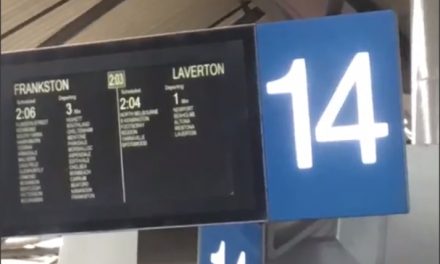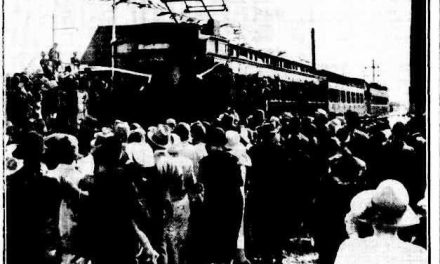If two trains that take you to the same destination arrive minutes apart, which will you take? You will say the first train based on common sense. Not so for the peak-hour passengers based at Laverton Station. Some commuters will pick the second train if it runs express between Laverton and Newport. By skipping the Altona Loop, a few minutes can be shaved off the journey despite the train departing later at the boarding station. Hence, passengers west of Altona will actually welcome any timetable change that will take the Altona Loop off the train schedule.
There are two major factors that determine the dynamics of train priorities in this area. The first is the physical limitation of the Altona Loop. Its single track creates a bottleneck, holding up a train as it waits for the train from the opposite direction to clear before it can run through the Loop. Altona is not alone in having this primitive rail structure. There are single-track sections in other parts of Melbourne, such as on the Epping, Hurstbridge, Lilydale and Belgrave lines, whose existence probably came about due to a combination of poor planning, lack of foresight and short-term cost-savings outweighing long-term benefits. The Altona Loop is unique in that the Werribee Train can bypass it by travelling in a separate set of tracks north of residential Altona while I do not think trains in other lines can bypass their single-track sections.
The second factor is the relative population of Altona to that of its more westerly neighbours. Altona is an oddity sandwiched between two more populous areas. We have the higher density Newport and Yarraville on one side, where median land size is generally smaller than that of Altona. On the western side is the City of Wyndham, the fastest growing municipality in Victoria and the fourth fastest in Australia (Ref 1). The Wyndham area is now riding a population boom, a favourite with first home buyers and new migrants, due to its housing affordability and land availability. In the foreseeable future, the patronage of the Werribee Line will increase substantially in line with the population growth in this area.
As the last Zone 1 train station, Laverton is a very heavily-utilized station, servicing people from the surrounding suburbs of Laverton, Point Cook, Altona Meadows, Seabrook, Williams Landing and Truganina and with catchment as far as Hoppers Crossing and Werribee. In contrast, though Altona has 3 train stations, its combined patronage is far less than that of Laverton alone. Altona has practically no remaining unbuilt land and is geographically limited from expansion by the sea in the south and the industries in the north. Hence, its population growth will be very much contained and the contrast from its western neighbours is bound to increase in the future. Consequently, the train operator will continue to introduce measures that will shift customer emphasis away from the Altona Loop.
However, it will be a great wastage not to make full use of 3 existing well-positioned Zone 1 train stations. As the Altona Loop runs through the middle of this wide and flat suburb, all houses in Altona are in fact within easy access of the 3 train stations. In an age when public transport is strongly encouraged to promote sustainability and environmental protection, we will be backpedalling if we do not optimize the usage of these 3 stations.
What should be done so that Altona is not marginalized in terms of train services with respect to the upstream faster growing areas? First of all, the Altona Loop needs to be duplicated to remove the existing bottleneck. This may not be too costly according to the Public Transport Users Association (PTUA) and is advocated by the PTUA and other rail experts (Ref 2, 3, 4). I do not know whether land has been reserved for the track expansion on the Altona Loop. This probably requires realignment of the existing tracks and removal of trees and vegetation besides the track. I am not sure whether this duplication will affect the roads and houses along the track. I had witnessed the building of the train infrastructure in Singapore. I was originally perplexed of how the existing roads could provide enough space to add the train tracks. The engineers were however very ingenious and managed to achieve what the layman wold think impossible. In Melbourne, you would have noticed how additional lanes and ramps have appeared miraculously on Princes Freeway/M1 near the Westgate Bridge. Hence, one should not doubt what feats engineers could come up with. Another issue that will be of great concern to the Altona passengers is whether the Altona Loop will be closed during the period of duplication. I could not answer this question as I am not a professional in this field. But I think the long-term benefits will be worth any short-term sacrifice. Of course, people living next to the track will oppose this plan as they will be adversely affected, ranging from the less significant such as inconvenience, dust and noise caused by the construction to major issues such as reduced road width and possible acquisition of properties.
Secondly, the population of Altona may need to increase to maintain a proportionate representation and influence on various population-dependent policies such as building of new infrastructure, services and getting its fair share of public transport priorities. As with other suburbs, this may not go down well with the majority of Altona residents who will oppose property subdivisions and building of higher-density housing such as townhouses and apartments. However, no Melbourne suburb will escape the effects brought about by increasing population, which include not only the rise of property value but also the emergence of more higher-density residences. Toorak, which is the most expensive suburb in Melbourne, has also a considerable number of apartments. I believe that it is only a matter of time before Altona experiences the same sort of density increase seen in other suburbs.
I am suggesting higher-density housing be encouraged in the immediately vicinity of the train station. Pier Street North is an obvious ideal candidate for this type of transformation. Nobody will object to the replacement of the light industries there with a mix of residential and commercial property developments. Shops could be on the ground and the second level, with apartments occupying the higher levels. This will improve the surrounding environment and make Altona a more chic and upcoming place. I do not advocate the building of higher-density housing further away from the train stations as this will increase the demand of carparking spaces at the stations. To prevent this from happening, there could be policies and incentives to encourage development of highrise residential buildings very close to the train stations. These buildings can go higher than the current 3-4 levels that we have seen and if they can provide ample supply, then there will be no incentive to build higher-density housing further away.
Thirdly, get more people to come to Altona. You do not need to be living in Altona to increase the usage of its train stations. The importance of the Altona Loop can be enhanced by making Altona the hubs for various activities, such as for sports and recreation, arts and culture, learning and education, nature seeking and so on. Altona is already developing in the direction of a family-oriented place. Why not further enhance this advantage by establishing a Educational Centre for Children and Teens, where parents can bring their children to learn various stuff such as tuitions, music, arts, sports, Taekwando and so on. Make this even bigger by incorporating other community activities and learning for adults as well such as calligraphy, painting, cooking lessons, knitting, yoga, parents’ clubs, etc. Expand the Fine Arts and Performing Arts in Altona. The trick is to schedule these activities in the non-peak hours so that incoming passengers to Altona will not compete with Altona residents during peak hours and the train usage will be more evenly spread throughout the day.
With the new timetable to be introduced in May this year and no indication that this change will be dropped, the Altona Community should think of ways of how to prevent the Altona Loop from being completely marginalized with further extension of the shuttle service to peak hours.





thats the way , put a great big scar slap dab in the middle of beautiful Altona, good thinking 99.
Just leave Altona alone
The cynics would have you believe that sightings of the Altona Loop Duplication are akin to sightings of unicorns, abominable snowmen, and the Tooth Fairy. But there were some actual sightings in 2018. They were triggered by the Kororoit Creek Rd Railway Crossing being replaced by a bridge. Unfortunately and unsurprisingly, a number of fairy tales accompanied the bridge-building. Here they are:
https://www.premier.vic.gov.au/altona-loop-dual-track-on-the-way-and-boom-gates-to-go/
[snip]
Kororoit Creek Road will soon be level-crossing free and Altona Loop services made more reliable following a 43- day construction blitz starting next month. As part of the Andrews Labor Government’s blitz, the Altona Loop along the Werribee line will power down from 7.30pm on 16 June to the last service on 29 July. This will allow crews to continue with the next stage of the crossing removal, including construction of a dual rail bridge over Kororoit Creek Road and duplication of track between the Werribee line junction and Kororoit Creek.
[end snip]
Fairy tale #1: Altona Loop Duplication is under way
Please note the nifty reference to “duplication of track”. This reached its epitome in an election flyer from Jill Hennessy Nov 2018 where direct reference was made to progressing the Altona Loop Duplication. In truth the new section of duplicated track is 800 metres in length, and a further 4,200 metres is required. Less than 20% of the job was done. The residents view “Altona loop Duplication” as the full 5km stretch. Branding a small section of work as Altona Loop Duplication is cute or spin.
Fairy Tale #2: Work is part of the Level Crossings Removal Program
The many media releases refer to the Kororoit Creek Rail Bridge as being part of the State Government’s Level Crossings Removal program. Actual statistics of harm are elusive, according to the State Auditor-General’s report, but the road crossing was #138 in the State’s most dangerous list. The same Auditor-General’s Report criticises the Government for branding the bridge works as part of the Level Crossings Removal. In truth, there are far more hazardous and inconvenient railway crossings in the Altona area, such as on Maidstone Rd. However those crossings do not have a negative impact on heavy vehicle time slot reliability at warehouses and do not have freight depots of major carriers just down the road. The bridge was built for the convenience of the Altona-based major players in the State’s road freight task. Anyone pushing a different conclusion must not have read the Auditor-General’s report and is full of spin.
Fairy Tale #3: The State Government is looking to the future for Altona Loop Duplication
Not actually said by the State Government, but talked about with *positivity* by every elected representative. Or maybe it actually has been said? How else to interpret the media release above, with its proud claim “Altona Loop Dual Track on the way”?
This is important, because the starting point for duplication work is to have designated railway reserve for track works.
In truth, it’s clear that no land has been bought nor has any reserve been declared. From the land deeds (plans) on public display at the Louis Joel Gallery in Altona as part of the Kororoit Creek Railway Bridge works public consultation process, the property boundaries narrow to a single track’s width just as the railway approaches Kororoit Creek waterway. There simply isn’t the room for a second track. A project manager informed me at that meeting that there were no plans afoot, to his knowledge, to buy the necessary land. So as you travel the line, be aware that where the two tracks meet at the end of the 800m of new work, well, that’s where the railway reserve narrows to single track width too.
****
I wouldn’t have been quite so interested in the gap between words and deeds on this matter if not for the new Werribee train timetable in 2008, the publicity for which said that services on the Werribee line were increasing by 30%. In truth, this turned out to come from counting the journeys of a new shuttle train between Laverton and Newport to feed travellers into a reconfigured Werribee service that avoided the Altona Loop altogether. The net result was that commuting from/to Altona was made harder not easier. That 30% more services claim was Fairy Tale #4.
That this happened under the watch of local MP the late Lynne Kosky who was also Transport Minister at the time, only added to local views of an uncaring government that took the West’s welded-on Labor vote for granted. Certainly there appears to be little action, by her at the time or by her colleagues since, for anything that might count as a enduring positive legacy for an allegedly much-loved colleague’s portfolio.
But there’s been lots of talk.